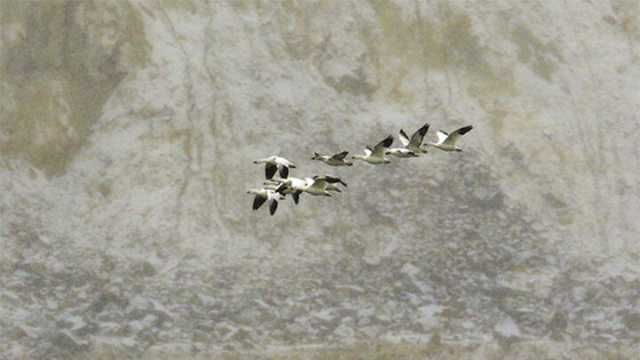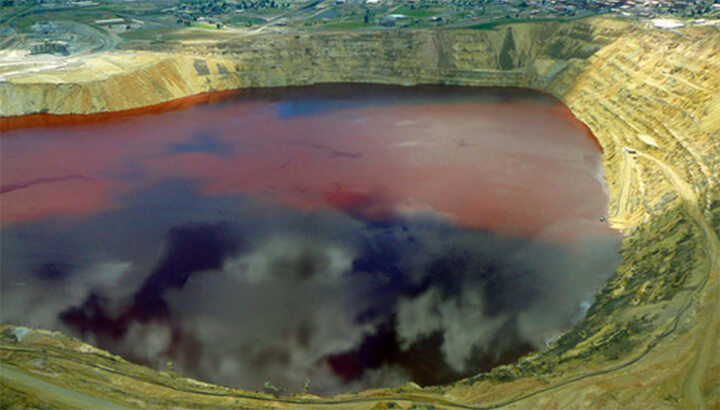
Several thousand snow geese died after a snowstorm forced large flocks to take refuge in the toxic waters of an old open pit mine in Butte, Montana. Now BP-ARCO and Montana Resources, who are responsible for the toxic pit, face fines. But a bigger question remains: How long does it take to clean up a toxic mess like this?
The deadly Berkeley pit
Butte, Montana, once known as “The Richest Hill On Earth,” has a long history in copper mining. But, a century of mining has left scars — and a huge toxic pit smack dab in the center. The Berkeley Pit was a copper mine opened in 1955, first operated by Anaconda Copper and later operated by the Atlantic Richfield Company. When it closed in 1982, workers turned off the water pumps in the nearby Kelley Mine, 3,800 feet below the surface. Groundwater from the surrounding aquifers began slowly filling the pit, rising at a rate of about one foot per month.
One mile long, half a mile wide and a depth of 1,780 feet, the pit is filled with heavily acidic water, similar to that of lemon juice. As a result, it became overloaded with dangerous chemicals and heavy metals such as copper, arsenic, cadmium, zinc and sulfuric acid leached from nearby rock.
A “superfund” site for the EPA
It soon became a U.S. Environmental Protection Agency (EPA) superfund site. A superfund site is any land in the U.S. that has been contaminated by hazardous waste. Identified by the EPA as a candidate for cleanup, superfund sites pose extreme risk to human health and/or the environment. These sites are placed on the National Priorities List.
Obviously, superfund sites also pose a tremendous threat ecologically to wildlife, including migrating birds. On November 28, a snowstorm forced about 10,000 migrating geese to land and take refuge in the artificial and toxic lake. Since then, thousands have been found dead, including two in a nearby Walmart parking lot.

Not the only tragedy for migrating birds
And, this isn’t the first-time geese have lost their lives to this lake. In November of 1995, a flock of migrating snow geese landed on the lake. After stormy weather and fog prevented the birds from leaving, the acidic water poisoned and burned 342 birds.
Originally, BP-ARCO and Montana Resources denied that the toxic lake had anything to do with the death of the geese, blaming the death on a previously acquired infection. But after the State of Montana conducted their own lab tests, they disputed BP-ARCO and Montana Resource’s claim.
Lab tests determined that excessive toxic exposure to pit water had corroded the birds’ esophagi. Since then, the pit has had a 24-hour bird-watch program. It prevents birds from landing in the water for more than a few hours. Unfortunately, it didn’t prevent the current disaster from unfolding.
Andrea Stierle, an organic chemist who’s studied the Berkeley Pit, tells “As It Happens” host Carol Off that birds drinking from the artificial lake will likely be dead within one or two days. When asked about her reaction to the birds landing in that pit this time, Stierle replied, “It broke my heart. When I heard from friends that they were hearing thousands of birds in the air over Butte, I immediately thought, ‘Oh no, I hope they don’t think the Berkeley Pit is a lake’.”
What happens now?
Apparently, the federal EPA has been managing the cleanup site since 1983. Joe Vranka, the EPA’s supervisor of Montana superfund sites, says they’re making progress in removing waste from the site. But, the EPA is allowing the basin to fill to a critical level before requiring Montana Resources and Atlantic Richfield Co., the current mine site managers, to begin pumping and treating the water to prevent contamination of nearby waters, Vranka said.
Sadly, that means the toxic lake remains a deadly nightmare for snow geese and any other birds that land there.
— Katherine Marko
Feature Photo: Snow geese fly along the banks of the Berkeley Pit toxic waters in Butte, Montana. (Photo Courtesy: Walter Hinick / Montana Standard).

